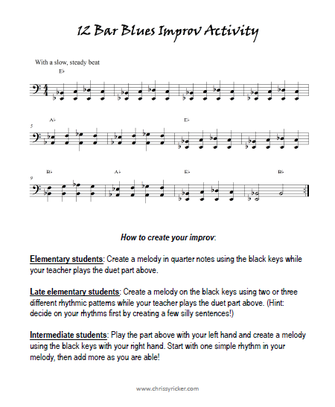I used this lesson plan with my first fall group class this past weekend and it was enjoyed by all. It was a great way to introduce my students to a few famous Gershwin tunes and to add a few jazz terms to their musical vocabulary. Here is what we did:
- To start the class, we played an icebreaker game of "name that tune." I played excerpts from two famous Gershwin tunes: "I Got Rhythm" and "Summertime." (I played from my Gershwin songbook, but you can find these songs on YouTube too!) Most of my students recognized these songs, especially once they heard the lyrics.
- I asked students what style they thought these songs were, which led us to learning a bit about the history of jazz, as well as a few jazz vocabulary words: "swing," "blue note" (or "bent note"), and "improv." A great, kid-friendly information page on the history of jazz can be found HERE.
- For our listening activity, I played an excerpt from Gershwin's "Rhapsody in Blue" as an example of jazz "concert" music. The Classics for Kids website has a great five-minute presentation on "Rhapsody in Blue" HERE. Or, you can use excerpts from this video of Leonard Bernstein playing the piano part while conducting the New York Philharmonic--a feat both me and my students found very impressive! (Be sure to point out the "blue notes" in the opening clarinet glissando and the trumpet solo.)

- 1. He was born on Sept. 26, 1898 in Brooklyn, NY. His parents were Russian immigrants.
2. George showed a great aptitude for music. Before he took piano lessons, he taught himself to play many songs on the piano by watching the keys on a player piano at a friend's house.
3. Though he was classically trained, Gershwin loved jazz and popular music and started working as a songwriter in Tin Pan Alley (a nickname for the street in New York City where many music publishers had offices) when he was only 15 years old. His brother Ira was the lyricist for many of his songs.
4. He wrote his famous "Rhapsody in Blue" in just three weeks, for a concert showcasing jazz and orchestra music.
5. He died on July 11, 1937, just a few days after being diagnosed with brain cancer. He was only 38 years old.
- Next, each student had a chance to perform a few pieces for the class. I had asked a couple of my more advanced students to be prepared to play a jazz piece from their repertoire, which gave us an opportunity to talk about the jazzy elements we heard in the music.
- Finally, to end the class we did an improv activity using 12 bar blues and the pentatonic scale. Since I had a wide range of levels in this class, ranging from less than a month of lessons to more than five years, I created an activity that I could customize for each student so that everyone could participate.

First, I had each student (even my more advanced students) create a melody on the black keys while I played the duet part. Once everyone was comfortable doing that, I had my most advanced student play the duet part while my less advanced students improvised their melodies, giving each student an opportunity to play duets with the others. We even turned it into a trio by having one student play the root of each chord low on the piano in whole notes in addition to the other two parts.
Click HERE if you would like to download this improv activity to try with your students!
I think this month's class was a hit! What do you think? Will you have your students learn a bit about Gershwin or do any improvising this September? I'd love to hear your comments!

 RSS Feed
RSS Feed